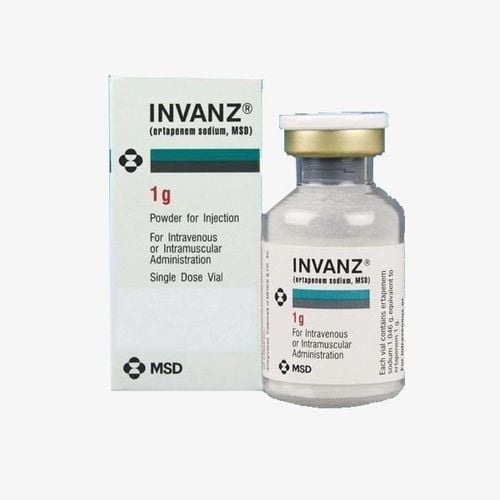This is an automatically translated article.
The active ingredient Davylox is Ciprofloxacin, a semi-synthetic antibiotic belonging to the fluoroquinolone group. The mechanism of action of the drug is to inhibit the enzymes DNA gyrase and topoisomerase IV, thereby inhibiting the synthesis of bacterial DNA. The drug is indicated in the treatment of many bacterial infections such as urinary tract infections, respiratory infections,...
1. What does Davylox do?
Davylox is indicated in the following types of infections:
Upper and lower urinary tract infections Prostatitis Pneumonia, especially when P. aeruginosa infection is suspected. Intra-abdominal infections Osteoarthritis. Severe bacterial enteritis Severe hospital-acquired infections such as bacteremia, sepsis in immunocompromised patients Prevention of meningococcal disease and infections in immunocompromised patients. Davylox is contraindicated in the following cases:
Patients with a history of hypersensitivity to Ciprofloxacin or to any of its components or to other quinolone antibiotics. Patient is being treated with tizanidine. Patients who are pregnant or breast-feeding, except in cases where the benefits outweigh the risks
2. Dosage of the drug Davylox
Davylox should be taken 2 hours after a meal. Patients should be told to drink plenty of water and not to take gastric antacids, metal ions such as iron, calcium within 2 hours after taking the drug. The length of treatment will depend on the type of infection and the extent of the disease. For most infections, treatment should continue for at least 48 hours after the patient is symptom-free. The duration of treatment is usually 1 to 2 weeks, but for severe or complicated infections, longer treatment may be required, such as 4-6 weeks for osteoarticular infections. Below is the recommended dose of Davylox in some cases:
Urinary tract infections: 250-500mg x 2 times/day Abdominal infections: 500mg x 2 times/day Pneumonia: 500-750mg x 2 times/day Uncomplicated gonorrhea: 500mg single dose Chronic prostatitis: 500mg x 2 times/day Skin-soft tissue infections, bone and joint infections: 500mg x 2 times/day Prevention of meningococcal diseases in adults and Children over 20kg: 500mg single dose; Children under 20kg: 250mg, single dose Prevention of Gram-negative infections in immunocompromised patients: 250-500mg twice a day
3. Davylox side effects
In general, Davylox is well tolerated. Side effects of Davylox may include:
Frequency of ADRs > 1/100
Gastrointestinal: Nausea, vomiting, dyspepsia, abdominal pain, diarrhea Metabolism: Transient elevation of transaminases Frequency 1/1000 < ADR < 1/100
Body as a whole: Headache, drug-induced fever. Blood: Eosinophilia, lymphocytopenia, neutropenia, anemia, thrombocytopenia Cardiovascular: Tachycardia. Central nervous system: Incitement to anxiety Gastrointestinal: Gastrointestinal disorders. Skin: Rash, pruritus, superficial phlebitis. Metabolism: Temporarily increased serum creatinine, bilirubin and alkaline phosphatase. Musculoskeletal: Joint pain, joint swelling. Frequency of ADR < 1/1000
Systemic: Anaphylactic reaction Blood: Hemolytic anemia, leukocytosis, thrombocytosis, prothrombin changes. Central nervous system: Convulsions, confusion, psychosis, paranoia, insomnia, depression, visual and auditory disturbances, increased intracranial pressure. Gastrointestinal: Pseudomembranous colitis. Skin: Skin-mucosal syndrome, vasculitis, Lyell's syndrome, erythema multiforme exudate. Liver: There have been reports of some patients with hepatocellular necrosis, hepatitis, and cholestatic jaundice. Muscle: Myalgia, tendinitis, inflammation of surrounding tissues. There have been a few cases of tendon rupture, especially in the elderly when used in combination with corticosteroids
4. Notes when using Davylox
To ensure safety when using Davylox, patients should note the following issues:
Caution should be taken when using Davylox for people with a history of epilepsy, central nervous system disorders, functional impairment liver function/kidney function, people with deficiency of the enzyme Glucose 6 Phosphate Dehydrogenase (G6PD), people with myasthenia gravis. Long-term use of Ciprofloxacin may lead to the development of antibiotic resistance. Use of Ciprofloxacin in children may lead to a risk of cartilage degeneration in load-bearing joints. Pregnant women: Davylox should only be used in pregnant patients in cases of severe infection and no alternative antibiotics are available. Lactation: Davylox should not be used by nursing mothers, as it may accumulate in breast milk and harm the infant. If the mother has to take the drug, she should stop breastfeeding.
5. Davylox drug interactions
Some interactions to note when using Davylox include:
Concurrent use of non-steroidal anti-inflammatory drugs with Davylox will increase unwanted effects of the drug. Concomitant administration of aluminum and magnesium antacids reduces the absorption and serum concentrations of ciprofloxacin. Therefore, patients should take the drug 2 to 4 hours apart. Preparations containing iron (ferrous fumarate, ferrous gluconate, ferrous sulfate), zinc, calcium will reduce the absorption of Ciprofloxacin by forming insoluble complexes. Patients should avoid concomitant use of Davylox with preparations containing iron, zinc, calcium or need to be separated by at least 2-4 hours. Concomitant use of Davylox and cyclosporin may cause a transient increase in serum creatinine. Therefore, serum creatinine should be checked every 2 weeks. Overall, Davylox is a commonly used antibiotic for many bacterial infections. To ensure effectiveness, reduce side effects and prevent antibiotic resistance, patients need to strictly follow the doctor's instructions and dosage.
Please dial HOTLINE for more information or register for an appointment HERE. Download MyVinmec app to make appointments faster and to manage your bookings easily.













